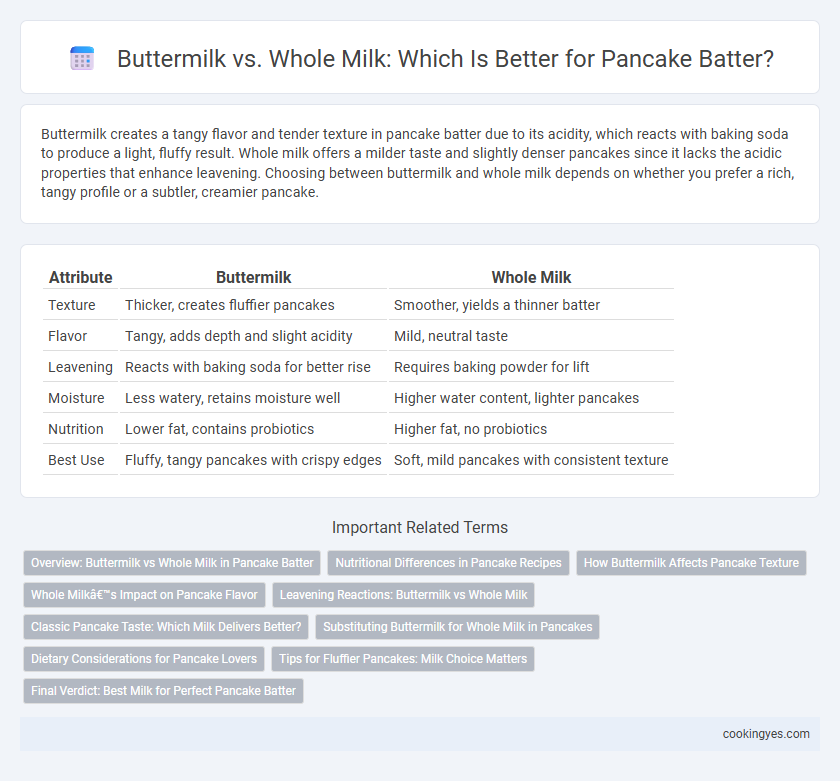Buttermilk creates a tangy flavor and tender texture in pancake batter due to its acidity, which reacts with baking soda to produce a light, fluffy result. Whole milk offers a milder taste and slightly denser pancakes since it lacks the acidic properties that enhance leavening. Choosing between buttermilk and whole milk depends on whether you prefer a rich, tangy profile or a subtler, creamier pancake.
Table of Comparison
| Attribute | Buttermilk | Whole Milk |
|---|---|---|
| Texture | Thicker, creates fluffier pancakes | Smoother, yields a thinner batter |
| Flavor | Tangy, adds depth and slight acidity | Mild, neutral taste |
| Leavening | Reacts with baking soda for better rise | Requires baking powder for lift |
| Moisture | Less watery, retains moisture well | Higher water content, lighter pancakes |
| Nutrition | Lower fat, contains probiotics | Higher fat, no probiotics |
| Best Use | Fluffy, tangy pancakes with crispy edges | Soft, mild pancakes with consistent texture |
Overview: Buttermilk vs Whole Milk in Pancake Batter
Buttermilk creates a tangy flavor and tender texture in pancake batter due to its acidity, which reacts with baking soda for better rise and fluffiness. Whole milk provides a milder taste and slightly denser texture, offering a creamy richness without altering leavening processes significantly. Choosing buttermilk enhances pancakes with a light, airy crumb and subtle tang, while whole milk yields soft, rich pancakes with a traditional flavor profile.
Nutritional Differences in Pancake Recipes
Buttermilk contains fewer calories and less fat compared to whole milk, making it a healthier option for pancake batter. It also provides beneficial probiotics and a higher protein content, which can improve digestion and increase the nutritional value of pancakes. Whole milk, while richer in vitamins A and D, contributes more saturated fat, impacting the overall calorie density of the pancake recipe.
How Buttermilk Affects Pancake Texture
Buttermilk's acidity reacts with baking soda in pancake batter, creating carbon dioxide bubbles that make pancakes fluffier and lighter compared to using whole milk. This reaction also tenderizes the gluten, resulting in a softer, more delicate pancake texture. Whole milk tends to produce denser pancakes with a firmer crumb due to its lower acidity and lack of leavening assistance.
Whole Milk’s Impact on Pancake Flavor
Whole milk enhances pancake flavor by adding a creamy richness and subtle sweetness that balances the batter's texture and taste. Its higher fat content compared to skim or low-fat milk contributes to a tender crumb and golden color, enriching the overall eating experience. The mild flavor of whole milk allows other ingredients, such as vanilla or spices, to shine while maintaining a moist and fluffy pancake structure.
Leavening Reactions: Buttermilk vs Whole Milk
Buttermilk contains lactic acid that reacts with baking soda in pancake batter, producing carbon dioxide bubbles for a lighter, fluffier texture. Whole milk lacks this acidity, so it relies on baking powder or other leavening agents to achieve similar rise. Choosing buttermilk enhances leavening reactions naturally, improving pancake volume and tenderness.
Classic Pancake Taste: Which Milk Delivers Better?
Buttermilk enhances pancake batter with a tangy richness and reacts with baking soda to create fluffy, tender pancakes, delivering a classic diner-style taste. Whole milk provides a milder, creamier flavor but lacks the acidity needed for optimal leavening, resulting in a denser texture. For traditional pancakes with a balanced, slightly tangy flavor and light crumb, buttermilk is the superior choice.
Substituting Buttermilk for Whole Milk in Pancakes
Substituting buttermilk for whole milk in pancake batter enhances the texture and flavor due to the acidity in buttermilk, which reacts with baking soda to create a fluffier, tender crumb. Buttermilk's slightly tangy taste adds depth to pancakes, while whole milk provides a milder flavor and softer structure. Using buttermilk also improves browning and moisture retention, making pancakes richer and more golden compared to whole milk-based batter.
Dietary Considerations for Pancake Lovers
Buttermilk contains lower fat and calories compared to whole milk, making it a preferred choice for health-conscious pancake lovers seeking a lighter option. Its natural acidity enhances leavening, resulting in fluffier pancakes without the need for extra baking soda. Whole milk offers richer taste and higher fat content, beneficial for those needing extra calories or a creamier batter texture.
Tips for Fluffier Pancakes: Milk Choice Matters
Using buttermilk instead of whole milk in pancake batter enhances acidity, which reacts with baking soda to create more carbon dioxide, resulting in fluffier pancakes. Buttermilk's thicker texture also adds richness and moisture, improving the overall batter consistency for better rise and tenderness. For optimal fluffiness, always allow the batter to rest briefly, enabling the buttermilk's acid to fully interact with leavening agents before cooking.
Final Verdict: Best Milk for Perfect Pancake Batter
Buttermilk creates the fluffiest, most tender pancake batter due to its acidity, which reacts with baking soda to produce extra lift and a richer flavor. Whole milk offers a milder taste and thinner consistency but lacks the chemical reaction that enhances pancake texture. For perfect pancake batter, buttermilk is the optimal choice to achieve light, moist, and flavorful results.
Buttermilk vs Whole Milk for Pancake Batter Infographic

 cookingyes.com
cookingyes.com